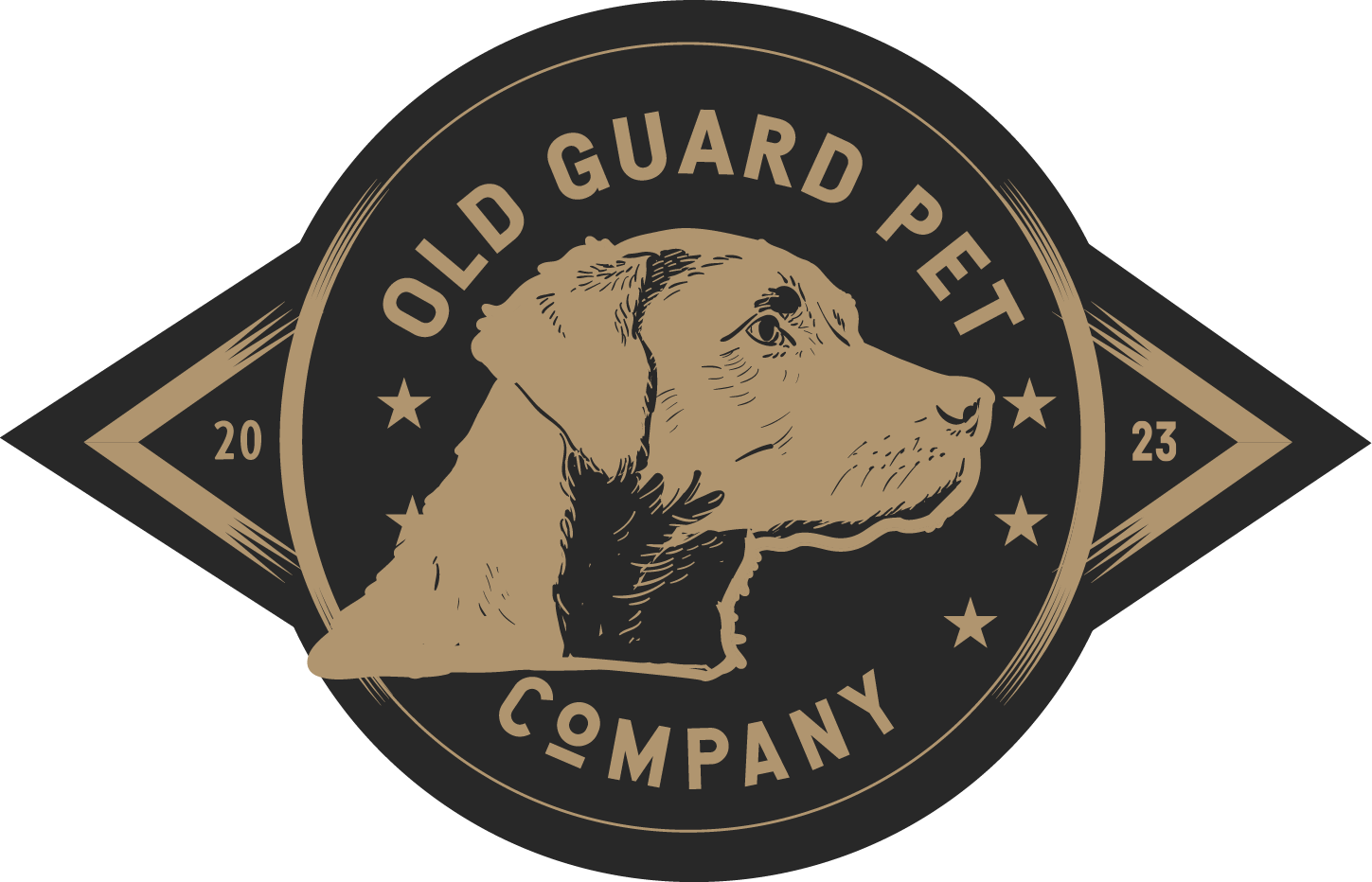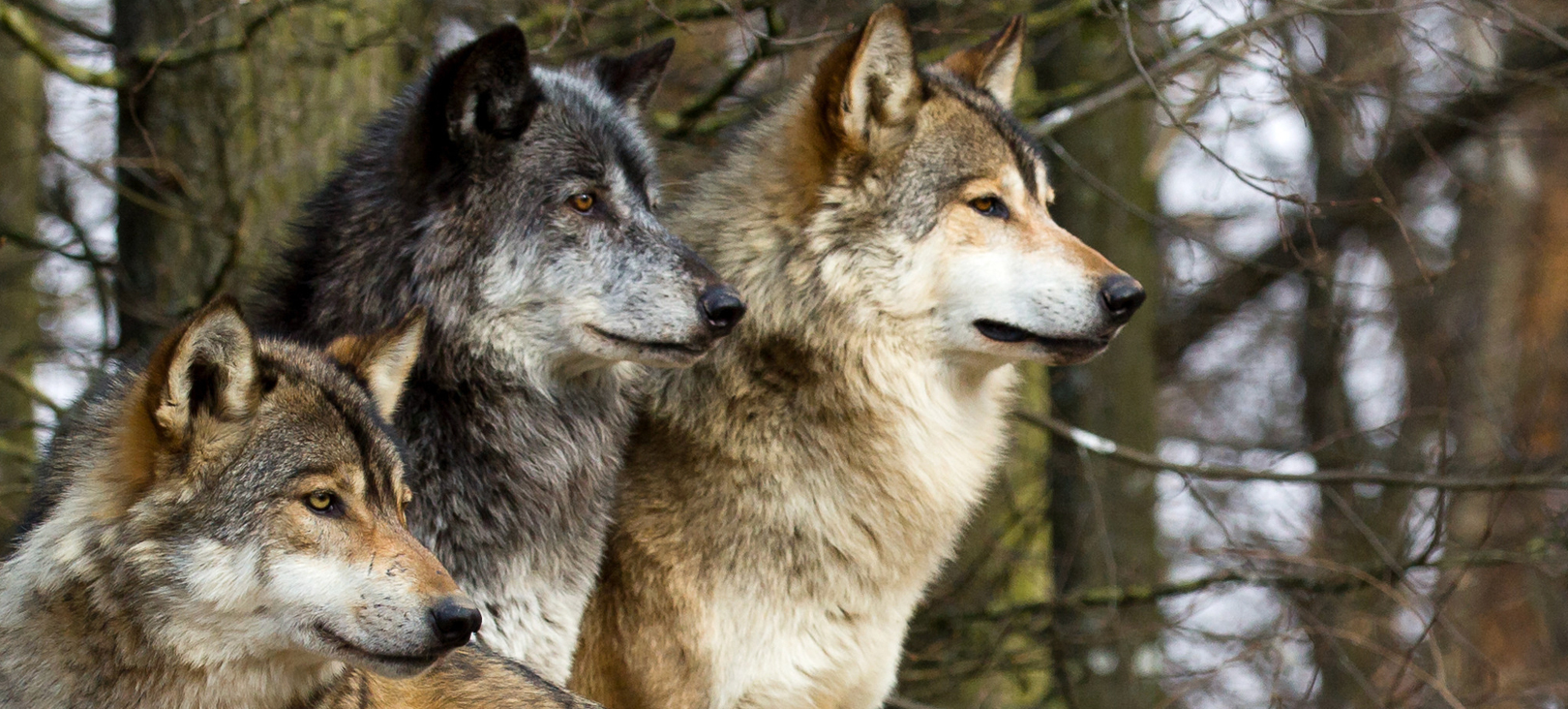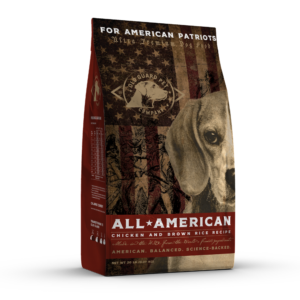The domestic dog sits in the Order “Carnivora” and are descendants of wolves so, dogs must be carnivores and should eat a diet of only meat, right? Not so fast. Dogs have naturally evolved over thousands of years, living alongside humans through the evolution of hunting and farming practices. As a direct result of this, there is a significant amount of evidence that the dog has evolved into an omnivore, meaning they eat both plant material and meat.
In this blog, we will review how the dog has uniquely evolved from the wolf and the unique nutritional needs of dogs that should be carefully considered when picking the right food for your dog to promote optimal health. There is sufficient evidence that suggests that the ideal diet for dogs should be a balance of protein, fat, carbohydrates, vitamins, and minerals.
Is it true that all animals, like the dog, in the Order “Carnivora” are carnivores?
Just because animals are classified as being in the order of “Carnivora” doesn’t mean they are carnivores. The most extreme example is the Panda, that resides in the order Carnivora despite being an herbivore who famously lives on a diet of bamboo. There are also species of animals in this group that solely eat fruit and seeds (called frugivores).
Jackals from the same genus as the domestic dog, are omnivores, and the coyote can also live on fruit and other plant materials when prey is difficult to find. The maned wolf eats a diet of 50% meat and 50% plant material. The diet of the gray wolf, Canis lupus, does consist predominantly of meat in most habitats in which it is currently found. Wolves historically occupied a wider range of habitats than they do today; thus, some researchers hypothesize that it is possible that they formerly consumed a more wide-ranging diet, inclusive of plants; however, this hasn’t been proven. On the other side, deer, classified as herbivores, have been documented as scavenging on carcass meat when necessary.
All of this to say that just because the dog is in the order Carnivora doesn’t mean that is reflective of the animal eating habits and there is evidence supporting that dogs are omnivorous which we will review below. But first, let’s look back at how we got to the “modern” dog.
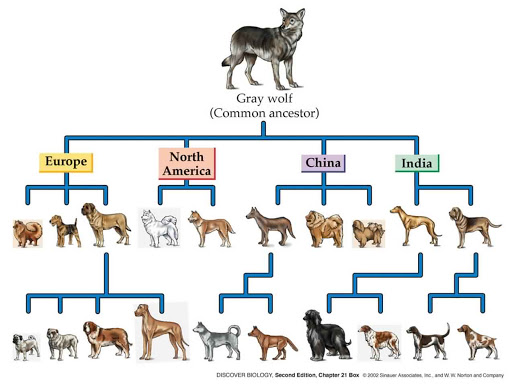
Dog Evolution Chart. Source: Neurologica
The domestic dog and the gray wolf likely evolved from a common ancestor.
Evidence suggests that dogs first became distinguishable in appearance from wolves ∼14,000 years ago; their mitochondrial DNA points to a much older common ancestor, perhaps >100,000 years ago but some estimates are also around 20,000 to 40,000 years ago. In fact, the origin of the domestic dog is relatively poorly understood, and researchers are still actively working to learn more.
Many believe that dogs evolved from gray wolves; however, dogs and wolves likely evolved from a common and extinct Siberian wolf ancestor, though again, the exact ancestor has not been identified. This could be since there were several domestication events that took place in different geographical locations in parallel. Given this significant duration of separation as species it is important to consider dogs and wolves separately. In fact, as we learn more about the evolution of dogs, we are learning how their biology changed.
How did domestication impact the dog and specifically dog’s nutritional needs?
Dogs often prefer large infrequent meals, and this preference is reflective of the competitive feeding behavior of its pack-hunting ancestor, the wolf, who can consume 15 to 19% of its body weight in one meal since the time of the next meal may be unknown. However, this is not necessarily consistent with all dog breeds and there is even variation in preference for larger meals vs. smaller more frequent meals within breed of dogs. If you look at the foraging strategies of feral dogs, they are scavengers and mostly consume both meat and plant material and smaller meals more frequently. Perhaps this behavior has evolved with domestication and breeding but, this remains unknown and the effect of flavors and palatants used in commercial foods can sometimes override these natural control systems.
Since domestication, dogs have been subjected to one of the most intense selection and breeding pressures, arguably of any animal in the world, and this has created one of the most diverse (with over 170 recognized breeds) populations within a single species. Originally, this intense breeding and selection was done to fulfill a human need, from guarding to hunting, and then over time this also transitioned into companionship. The dog’s genome or DNA allows for more variation or plasticity than many other species, meaning it is easier to create significant physical and genetic differences rapidly in coat color, size, shape etc. with selective breeding. Given this rapid evolution in genetics alongside humans we must consider dogs as a unique species from the wolf. Also, as we continue to learn more, we should start to look at each breed uniquely to determine what is consistent across all dogs and what is unique as it relates to nutrition. What we do know is that across all dog breeds there have been specific genetic changes that occurred with domestication related to metabolism.
Metabolic adaptations to new diets developed in dogs across various geographic locations mirror the dietary patterns of humans. This is thought to be because humans either directly (i.e. dogs were intentionally fed provisions of food) or indirectly (i.e. dogs scavenged on remaining scraps of food) fed the dogs around their habitats. An extreme example of this is in 7000 BC where analysis of dog feces shows that their diet was composed of 60 to 90% millet in regions of northern China. Similarly, dogs living near coastal regions had diets mainly of fish. Both examples caused biological and metabolic adaptation in the dog that remain visible in them today and that these changes are visible across all dog breeds. We will discuss what these exact changes are in the next section.
What are the key differences between dogs and wolves and how does this impact their nutrition?
Dogs and wolves share about 98-99% of their DNA. However, as we just discussed there are still significant genetic variations leading to visible and invisible differences between the dog and wolf as well as between breeds of dogs. This diversity is largely due to the unique way nucleotides (the building block of DNA) fit together (each forming a unique puzzle that is specific to a certain breed or characteristic).
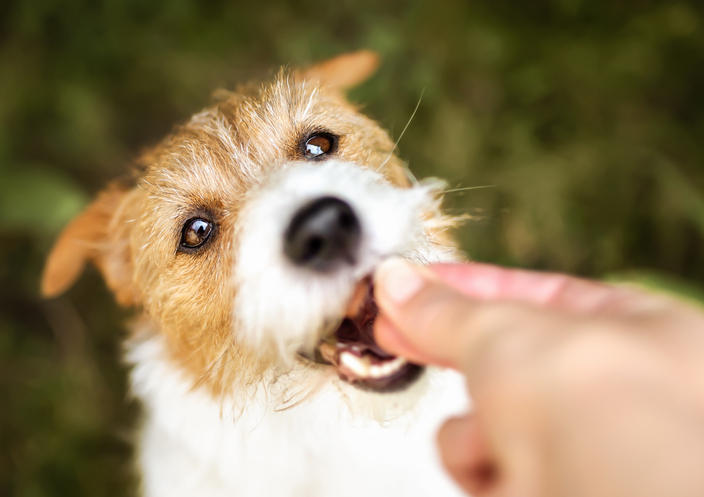
Hand giving snack treat to a healthy dog. Check out our Battle Biscuits!
In addition, one newer area of research is called epigenetics. Epigenetic’s is the study of how behaviors and environment can cause changes that affect the way your dog’s genes work. Epigenetic changes do not change DNA sequences but change how your body reads a DNA sequence. These changes affect gene expression by essentially turning certain genes “on” and “off” (called DNA methylation). These factors can affect your physical characteristics and can be inherited or impacted by environment, diet etc. making them important in the evolutionary process and are often overlooked when discussing differences between wolves and dogs. Recently, a group of researchers investigated the differences between wolves and dogs in reference to DNA methylation of the brain and found significant differences impacting their overall behavior. This is one example of why it is important to think beyond DNA only because while dogs DNA may be similar to wolves, there are many significant differences that still exist and which create huge differences between dogs and wolves and even dog breeds.
Key differences between dogs and wolves:
Physical: From a physical perspective, wolves have larger brains, skulls and jaws compared to dogs. The bite pressure of a wolf far exceeds that of the German Shepherd. There are also other physical differences like coat and eye color, tail shape, hip and shoulder width, etc.
A great example of the impact of domestication and breeding on appearance was a study done on the silver fox. Researchers only selected and bred foxes for tameness but, this inadvertently resulted in foxes having physical features more like a dog (wider eyes, shorter nose etc.).
Behavior: Wolves, even those that have been raised by humans, still possess large behavioral differences from dogs specifically when it comes to problem solving skills and social skills (or sociocognitive skills). Dogs look for human cues more versus wolves that work independently. This is likely due to dogs having been domesticated over thousands of years, while even those wolves living with humans, have done so for a much shorter period.

Large male grey wolf
Metabolic/Nutritional: There are numerous physiological and genetic changes documented which, due to food intake, have made them less adapted to diets typically consumed by wolves.
- Starch (Carbohydrate) Metabolism: Dogs possess three genes (AMY2B, MGAM, SGLT1) that play key roles in the breakdown of starch that wolves do not have.
- Starch (Carbohydrate) Metabolism: Dogs have more copies of amylase, an enzyme for starch breakdown, than wolves.
- Starch (Carbohydrate) Metabolism: Dogs have similar maltase enzymes to that of herbivores (which are different from wolves).
- Gut Microbiome: There are differences in the gut microbiome of dogs and wolves with dogs showing a microbiome more suited to lower protein and higher starch intake than wolves (in function and composition of the microbial population). Further, when dogs were transitioned from a commercial diet to a raw diet the microbial response of the dog’s gut was different to that of wolves, further suggesting they have shifted their ability to handle raw diet typically higher in fat and protein.
- Fat Metabolism: Genes involved in fatty acid metabolism changed during evolution during the domestication of dog’s vs wolves; specifically, gene (ACSM2A) which initiates the breakdown of fats. However, more research is needed to understand the impact of this change on the dog’s fatty acid metabolism.
Overall, these findings have led some researchers to suggest that carbohydrates might be more beneficial than previously perceived for certain working dogs or growing puppies (who have high energy demands) to ensure there is more sustained energy available between meals. What is important to look at is the type, cooking and amount of carbohydrate.
Conclusion: Dogs have evolved unique metabolic differences from wolves
In summary, given the similarities but also very important differences between dogs and wolves, we must consider them individually when it comes to health and well-being with a large part of that consideration being diet. Dogs have unique needs that are different from wolves and even between specific dogs. We know additional emphasis in choosing a diet should consider large vs. small breeds, young vs. older dogs, and other factors, and the amount of research is only growing in this area. Simply using the theory that dogs evolved from the wolf oversimplifies the extreme and relatively intense domestication and selection pressure from breeding that occurred and the evolutionary impacts of diet and the environmental shifts that have occurred.
The sad reality is that ignoring the evolution and specific needs of dogs is not just happening with some raw foods, certain kibble brands play into the misconception that dogs and wolves are the same (even proudly displaying images of the wolf on the packaging) and a few years ago there was an expansion in popularity of so called, “ancestral” diets. These diets included very high levels of protein and few or no grains. However, more recently the inclusion of grains has expanded and there is a movement away from these “ancestral” diets. The unfortunate thing about pet food companies following trends, without scientific basis, means that dogs are potentially fed inappropriate diets as marketing gimmicks. Science doesn’t need to be unnatural. What is natural is respecting the history, evolution, and unique needs of dogs objectively and this is our mission at Old Guard, Ultra Premium Dog Food. We hope this information helps you understand how to evaluate the best diet for your dog.
References:
- Dietary Variation and Evolution of Gene Copy Number among Dog Breeds | PLOS ONE
- Frontiers | The Fecal Microbiota of Dogs Switching to a Raw Diet Only Partially Converges to That of Wolves (frontiersin.org)
- The silver fox domestication experiment | Evolution: Education and Outreach | Full Text (biomedcentral.com)
- The genomic signature of dog domestication reveals adaptation to a starch-rich diet (researchgate.net)
Five Dog Food Nutrition Secrets From a PhD
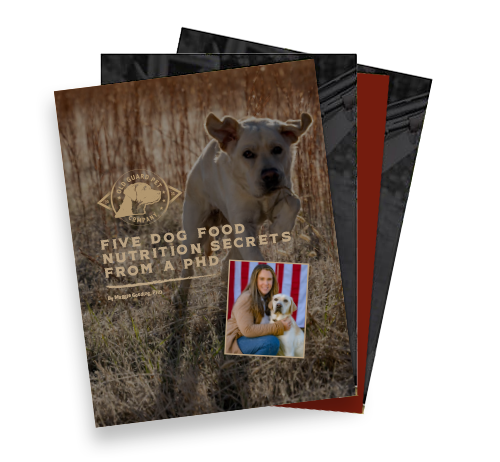
With so much information floating around out there on dog nutrition, how can you be sure you have the facts? In this guide, Founder Maggie Gooding, PhD, in Animal Nutrition and Behavior, with over a decade experience in R&D working on some of the largest pet food brands share five nutrition secrets to help your dog live a longer healthier life.
Get the inside scoop on:
- Nutrients
- Energy Balance
- Weight Control
- Dog Eating Habits
- Fibers and Fillers
Download by filling the form out below:
